Announcements
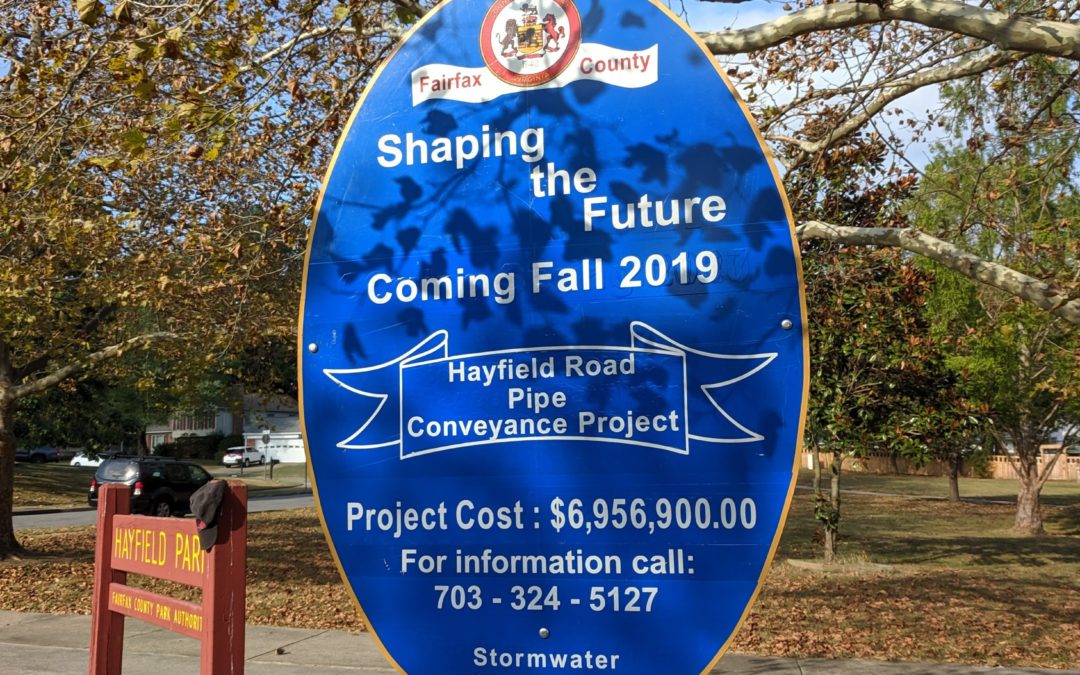
Hayfield Road Pipe Project: 1/24/20 (+1 Maple Tree)
by John Millikin
Yesterday I received an update from Project Manager Dave Anglin; unfortunately one more maple tree (near 7721 Hayfield Road) must be removed; this will occur sometime between January 23 and the middle of February. We know that in a $7,000,000 project that there will be unforeseen surprises like this one. I encourage everyone to read the justifications that Dave provides and to remember the overall significant benefits that this project brings to Hayfield Farm residents.
Here are the justifications that Dave Anglin sent on Wednesday January 22
“Attached are two pictures showing the circumstances regarding this (maple) tree. Below is a summary explanation with more details in the attached picture mark-ups.
The work is not just encroaching some into the critical root zone. With the work required at this location, the open excavation and required trench box will be well within the tree’s drip line. Add the additional space required to prune the roots and this is up to the tree trunk/root crown. So, root pruning will sever the tree’s root system greater than 40 percent. This poses a severe risk that this size tree will not survive the work in the long run.
Additional risks, beyond/addition to the survivability question:
- Immediate – this tree is near an area where problem soils started slumping/collapsing into and ground water was encountered in the open excavation. So, if the supporting soils slough, this poses a risk to project personnel and near-by others/property of immediate tree collapse.
- Long-term – large structural roots will be cut on virtually half the tree. Short of the tree dying, severing major structural supporting roots risks the tree falling in the future during wind events and/or during very wet weather.
Given the design, I now believe this was always unavoidable. I just wish we had foreseen so the information could have been shared earlier.”
Here is the text in the first picture: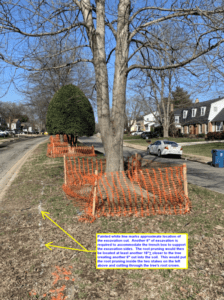
“Painted white line marks approximate location of the excavation cut. Another 6″ of excavation is required to accommodate the trench box to support the excavation sides. The root pruning would then be located at least another 18″+ closer to the tree creating another 6″ cut into the soil. This would put the root pruning inside the two stakes on the left above and cutting through the tree’s root crown.”
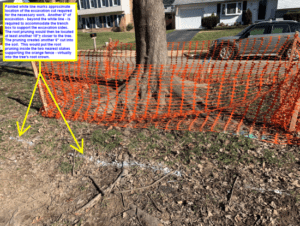 Here is the text in the second (close-up) picture:
Here is the text in the second (close-up) picture:
“Painted white line marks approximate location of the excavation cut required for the necessary work. Another 6″ of excavation – beyond the white line – is required to accommodate the trench box to support the excavation sides. The root pruning would then be located at least another 18″+ closer to the tree. The pruning creates another 6″ cut into the soil. This would put the root pruning inside the two nearest stakes supporting the orange fence – virtually into the tree’s root crown.”

Hayfield Road Pipe Project: Root Pruning
RESEARCH LABORATORY TECHNICAL REPORT from Bartlett Tree Experts
Root Pruning
Kelby Fite, PhD, Plant & Environmental Science and E. Thomas Smiley, PhD, Urban Forestry
Root pruning is the process of cutting roots prior to mechanical excavation near a tree. Root pruning may be necessary to minimize damage to the tree’s root system during construction or in preparation for large tree transplanting. Improper root pruning and root damage from excavation can cause great harm to a tree which may affect tree health and/or structural stability. A tree risk assessment should be performed prior to cutting any roots and alternative techniques, such as boring under the roots, should be considered.
Root Pruning Methods
When pruning roots, there are guidelines regarding size: roots less than one inch (2.5 cm) in diameter can easily be cut with hand tools while cutting roots greater 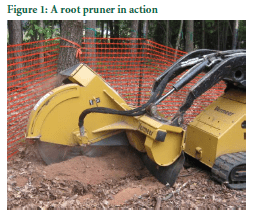 than three inches (7.5cm) in diameter should be avoided whenever possible. There are three general methods of root pruning in the one- to three-inch diameter range:
than three inches (7.5cm) in diameter should be avoided whenever possible. There are three general methods of root pruning in the one- to three-inch diameter range:
- Air/Water/Hand Excavation and Pruning
Excavating roots requires the use of the AirSpade®, hydro excavation or hand tools. This exposure allows the arborist to evaluate the best places to cut, preferably beyond sinker roots or junctions. Roots can be cut most cleanly with a sharp saw or lopper. Exposed fine roots that are to be preserved may be covered with burlap and sprayed with water, or they can be sprayed with a hydrated, fine, water-holding gel to prevent desiccation.
- Root-cutting Machinery
A root pruner, such as the Dosko or Vermeer Root Pruner, is faster than the previous method (Figure 1). These tools have teeth similar to a stump grinder and provide relatively clean root cuts. However, this method does not allow for the arborist to evaluate the exact location of the pruning cuts and will, likewise, be indiscriminate.
- Trencher or Excavator
 A chain trencher or excavator is one of the worst ways to prune roots because they often lift surface roots out of the soil until they break and leave other roots crushed or torn. After using a trencher, it is better to prune the damaged ends by hand than to leave them untreated. Sometimes, due to site constraints, trenchers are the only option due to their flexibility.
A chain trencher or excavator is one of the worst ways to prune roots because they often lift surface roots out of the soil until they break and leave other roots crushed or torn. After using a trencher, it is better to prune the damaged ends by hand than to leave them untreated. Sometimes, due to site constraints, trenchers are the only option due to their flexibility.
Root Cut Placement
The further from the trunk that root cutting occurs, the better, but generally root cuts made outside a normal dripline of a tree rarely cause permanent tree damage. The preferred minimum distance from the trunk to the closest root cut is 5 to 6 times the Diameter at Breast Height (DBH).
For example, with a 12-inch (30 cm) diameter tree, the root cut distance should be 60 to 72 inches (5 to 6 feet, 1.5 to 1.8 m). At this distance, there should be minimal impact on the health or stability of most tree species with proper aftercare.
For root cuts on only one side of a tree, the root cut distance can be somewhat closer to the trunk than cuts on more than one side. The preferred minimum distance in this case is three times the DBH. For example, with a 12-inch (30 cm) diameter tree, the distance would be 36 inches (3 feet, 0.9m) (Figure 2). This distance is too close if there is pavement over the other side of the root system, if the tree has root decay, is leaning or has other indications of root disturbance. These trees also need proper aftercare to reduce the risk of health problems.
In all cases, consider variables such as tree species, age, tree health, and soil characteristics (including the presence of underground root obstructions) when determining location of root pruning. Cuts made closer to the trunk may dramatically compromise stability and health and should be avoided.
Plant Health Care Before and After Root Pruning
Tree health and soil moisture should be monitored frequently following root pruning. Root pruning should not be done immediately prior to or during a drought period unless the tree will have adequate irrigation. Irrigation should be applied prior to and after root pruning if there is not adequate rainfall. Monitor for secondary pests and apply protective treatments to susceptible trees for lethal invaders such as borers. Fertilizer and soil amendments should be applied according to soil or foliar nutrient analysis test results. Root Invigoration should be performed to promote root regeneration and a better environment for remaining roots. At a minimum, mulch should be applied to reduce soil moisture loss and promote root growth.
Founded in 1926, The Bartlett Tree Research Laboratories is the research wing of Bartlett Tree Experts. Scientists here develop guidelines for all of the Company’s services. The Lab also houses a state-of-the-art plant diagnostic clinic and provides vital technical support to Bartlett arborists and field staff.

Hayfield Road Pipe Project: 1/21/20
by John Millikin and Dave Anglin
Garney Construction, the County’s contractor, worked on Monday, January 20 which is Martin Luther King Jr. Day, a federal holiday. Garney will follow Fairfax County’s Noise Ordinance for federal holidays, i.e., no construction related noise in the community before 9 am.
The contractor ran into very unstable soils January 13-16 (marine clay and ground water have been issues) while trying to complete the new sanitary sewer main and lateral connections. They returned to the bottom of the hill (near Hayfield Pool) and began  work on the new conveyance system outfall and plunge pool Friday January 17. Then, they continue this work up the hill based on the design plan. When the work progresses to the same point as where the sanitary is temporarily halted, the contractor will resume and complete the sanitary work along with the new storm pipe installation. The new sanitary main extends to the final house fronting on Hayfield Road at Bridgewater Court
work on the new conveyance system outfall and plunge pool Friday January 17. Then, they continue this work up the hill based on the design plan. When the work progresses to the same point as where the sanitary is temporarily halted, the contractor will resume and complete the sanitary work along with the new storm pipe installation. The new sanitary main extends to the final house fronting on Hayfield Road at Bridgewater Court
Titan Tree Care was scheduled to perform root/limb pruning on Monday January 20 only for trees between Hayfield Road dead end by the pool and Broadmoor Street on the Hayfield Road median. This aligns with the project plans to preserve the trees on the median strip. This work is similar to previously described pruning the above grade tree limbs to remove work obstacles and to protect the trees while the contractor open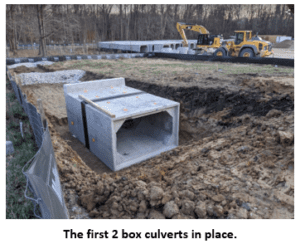 s the road to install the box culvert sections. This root/limb pruning is a similar plant health management effort occurring in the underground root zone. This is work will provide best efforts to protect the health of the trees closest to the open excavation. Recall that one of Fairfax County’s arborists met with Garney’s arborist to review the work and discuss best management practices prior to beginning work. Also see the attached document (root-pruning.pdf) for details about root pruning.The contractor ran into very unstable soils January 13-16 (marine clay and ground water have been issues) while trying to complete the new sanitary sewer main and lateral connections. They returned to the bottom of the hill (near Hayfield Pool) and began work on the new conveyance system outfall and plunge pool Friday January 17. Then, they continue this work up the hill based on the design plan. When the work progresses to the same point as where the sanitary is temporarily halted, the contractor will resume and complete the sanitary work along with the new storm pipe installation. The new sanitary main extends to the final house fronting on Hayfield Road at Bridgewater Court.
s the road to install the box culvert sections. This root/limb pruning is a similar plant health management effort occurring in the underground root zone. This is work will provide best efforts to protect the health of the trees closest to the open excavation. Recall that one of Fairfax County’s arborists met with Garney’s arborist to review the work and discuss best management practices prior to beginning work. Also see the attached document (root-pruning.pdf) for details about root pruning.The contractor ran into very unstable soils January 13-16 (marine clay and ground water have been issues) while trying to complete the new sanitary sewer main and lateral connections. They returned to the bottom of the hill (near Hayfield Pool) and began work on the new conveyance system outfall and plunge pool Friday January 17. Then, they continue this work up the hill based on the design plan. When the work progresses to the same point as where the sanitary is temporarily halted, the contractor will resume and complete the sanitary work along with the new storm pipe installation. The new sanitary main extends to the final house fronting on Hayfield Road at Bridgewater Court.
It is far better to have a dedicated effort to cleanly cut the roots rather than have this occur during actual excavation work. This is driven almost exclusively by the 7’x4’ box culvert installation. The excavation becomes less of an issue when Garney switches over to the 48” pipe (beyond the Hayfield Road and Broadmoor Street intersection) as the work moves toward Telegraph Road. It becomes a non-issue after the sanitary main work is complete.
Questions and Answers
- Are truck deliveries continuing on Saturdays?
- Eight semi-truck deliveries were scheduled for Saturday, January 18. The Jan. 18 and Feb. 25 deliveries are postponed. Future box culvert and 48” reinforced concrete pipe deliveries will be announced later when the schedule is confirmed.
- What is the status of new sanitary sewer connections?
- Sixteen houses now have sanitary sewer connections completed; seven houses remain to be connected, assuming that #7710 has not yet been connected.
- What is estimated date to begin installing box culvert sections?
- Garney Construction began work on January 17 to install box culvert sections under Hayfield Road near the Hayfield Pool in conjunction with work on the outfall and plunge pool, i.e., Friday January 17.
- Where can I find more information about root pruning?
- See the “RESEARCH LABORATORY TECHNICAL REPORT”.

January Hayfield News 2020
Check out the January Hayfield News. Included in this issue: Hayfield Road Pipe Conveyance System Update, Hayfield Happenings, etc.

Hayfield Road Pipe Project: Truck Deliveries Dec 7, 14, 21
Hayfield Road Pipe Project Manager Dave Anglin sent the following information on December 4 along with apologies for the short notice. He will work with the contractor to make sure we receive as much notice as possible on any future activity that could disturb the neighborhood. The contractor (Garney) plans to receive pre-cast box culvert sections over the next three Saturdays (December 7, 14 and 21).
Those living along Hayfield Road may want to avoid parking on Hayfield Road on these three Saturdays from 7:00 AM to 5:00 PM or until the last of 12 tractor trailer flat-bed trucks leaves the neighborhood. There are two especially important areas to keep clear: (1) the south bound section where the pool property fronts along Hayfield Road to allow sufficient room for trucks to turn into the parking lot drive way; (2) it will also be helpful if the residents at 7815, 7817, and 7819 Hayfield Road will avoid parking on the street, if possible. The tractor trailer will need room to make the left turn out of the pool property onto Hayfield Road. It will be a tight turn even with the full northbound lane width open. Any cars parked in front of these homes will make that turn more difficult.
The culvert sections will arrive on tractor trailer flat-beds trucks. The reason they do this on Saturdays is due to manpower and safety. A 5-man crew is required to safely unload the culvert sections and that crew is usually busy with the sanitary main pipe work during the normal work week days. They will bring in a total of 12 trucks over a 10-hr workday. Each truck has 3 sections, and each section takes about 30 minutes to properly offload. The first delivery will be at 7:00 a.m. and we made it quite clear that they cannot enter the neighborhood prior to 7:00 a.m. (Unfortunately, the noise ordinance limits work prior to 9:00 a.m. only on Sunday and federal holidays.) The delivery trucks will be able to turn right down into the laydown area in the pool parking lot to off load and then depart. This is the first delivery set for the pre-cast culvert sections. The remaining culvert sections will not be ready until the end of January. Dave will provide as much advance notice about that schedule as possible.
Reminder about Replacement Trees / Hayfield Road Pipe Project
Mary Millikin, HCA Beautification Chair, wants to remind Hayfield Farm residents about the County’s requirement for replacement trees. To address any concerns about replacement trees for trees that are removed, the County is requiring the contractor to replant the same type of trees that they removed in the same places. Those trees include red maples, American hollies and redbuds. The “100% Design Plan for the Hayfield Road Pipe Conveyance System” dated July 9, 2018 specifies this on page 96.
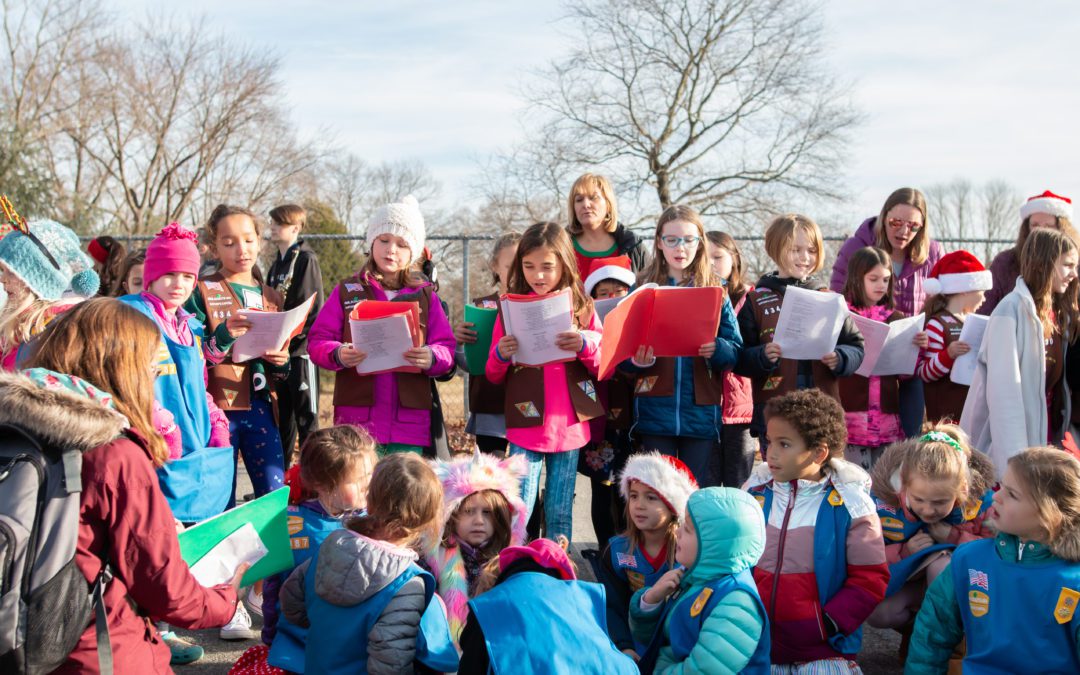
December Hayfield News 2019
Check out the December Hayfield News. Included in this issue: Hayfield Road Pipe Conveyance System Update, Garden Club Clippings, Hayfield Happenings, etc.

Recent Comments